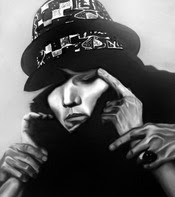 Photos: Ferintus Karbon
Photos: Ferintus KarbonAlia Swastika, the curator, is delivering her speech accompanied by Tubagus P. Svarajati and Mella Jaarsma.
IT WAS hot and bright afternoon, Saturday 15, 2007, when some students entered the space. They, by seeing the exhibition-to-be-opened “The Past-The Forgotten Time”, spent their time before ‘buka puasa’, that is the time – usually a few minutes before 6 o’clock in the evening – when Mosleems are allowed to eat after a full-happy-day-fasting.
The surprising thing is the fact that they are not only Indonesian but also some students from abroad. They, according to Riris – student of IKIP PGRI who become a teacher, surely, when she has completed her study and directly gets job! – come from China, Vietnam, South Africa, and a list of countries I forgot. They are part of some students who are studying Bahasa in some Semarang’s universities. Well, it’s good to know we have some new audiences.
 The exhibition was afficiated by Mrs Widjajanti Dharmowijono. Before her, I – Tubagus P. Svarajati – announced to audiences a brief explanation why such event was conducted here. And Mella Jaarsma, the artist who owned – with his husband – Cemeti Art House (CAH), gave her speech on the mutual cooperation between CAH and RSY. Then Alia Swastika, the artistic manager of CAH and the curator of the exhibition, delivered some notes on the background what the theme of the exhibition is, the reasons why the artists were chosen, and so on.
The exhibition was afficiated by Mrs Widjajanti Dharmowijono. Before her, I – Tubagus P. Svarajati – announced to audiences a brief explanation why such event was conducted here. And Mella Jaarsma, the artist who owned – with his husband – Cemeti Art House (CAH), gave her speech on the mutual cooperation between CAH and RSY. Then Alia Swastika, the artistic manager of CAH and the curator of the exhibition, delivered some notes on the background what the theme of the exhibition is, the reasons why the artists were chosen, and so on. Mrs Dharmowijono noted that we Indonesian usually blame the past, the history, whenever we fail to construct our own. She said, we do not forget the past, but neither we hide before it. We could choose to write down our own history and probably that is what we called as freedom. In a way, whether we like it or not, Indonesian and the Dutch have shared history. It is cliché when we call that history equals to ‘his/her story’. But is that true history belongs to whom has the power to reign?
Mrs Dharmowijono noted that we Indonesian usually blame the past, the history, whenever we fail to construct our own. She said, we do not forget the past, but neither we hide before it. We could choose to write down our own history and probably that is what we called as freedom. In a way, whether we like it or not, Indonesian and the Dutch have shared history. It is cliché when we call that history equals to ‘his/her story’. But is that true history belongs to whom has the power to reign? In the other part Mrs Dharmowijono said, “We in turn were not as passive viewers only, but also bring our knowledge, experiences and feelings to interpret ourself and to every art-works. This exhibition which involved six artists is amazing for it also comes from great ideas.”
In the other part Mrs Dharmowijono said, “We in turn were not as passive viewers only, but also bring our knowledge, experiences and feelings to interpret ourself and to every art-works. This exhibition which involved six artists is amazing for it also comes from great ideas.” After all there was an artists’ talks delivered by Wimo Ambala Bayang and Yuli Prayitno, two of six artists who are exhibiting. The curator also gave her speech. And the discussion was moderated by Seno Satrio Prakoso from Widya Mitra Foundation.***
After all there was an artists’ talks delivered by Wimo Ambala Bayang and Yuli Prayitno, two of six artists who are exhibiting. The curator also gave her speech. And the discussion was moderated by Seno Satrio Prakoso from Widya Mitra Foundation.***











+of+DSC05301.jpg)




